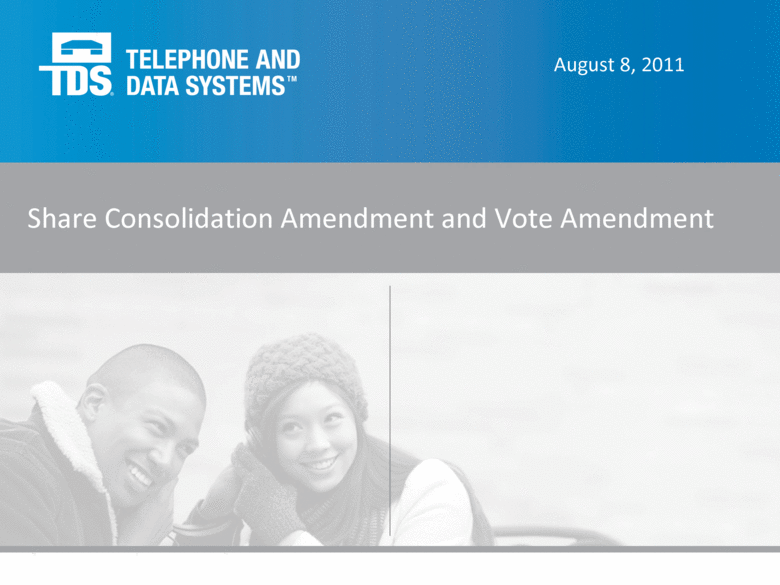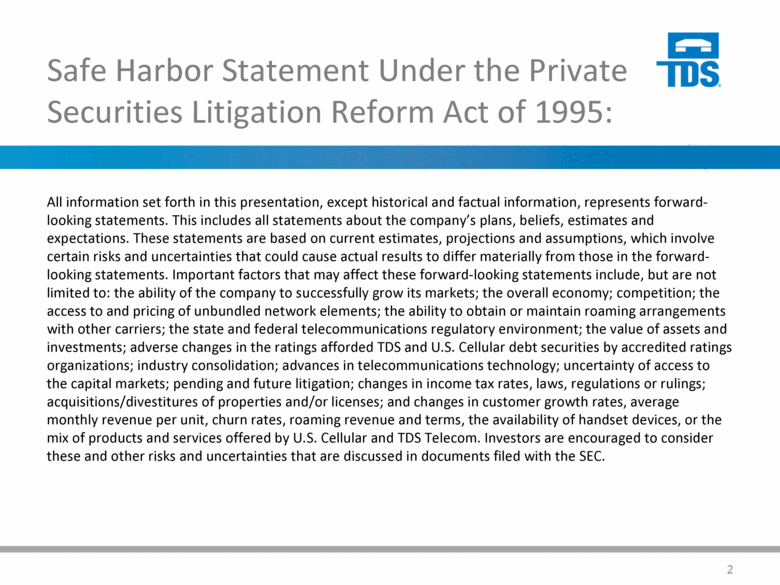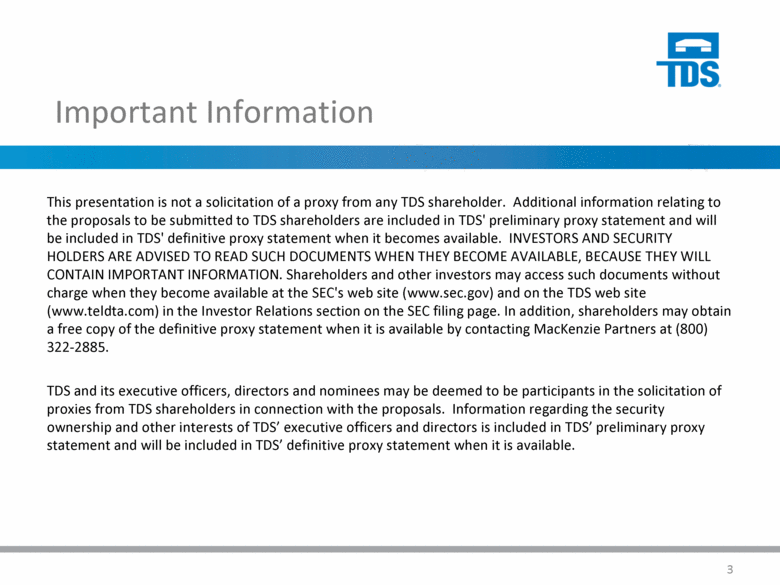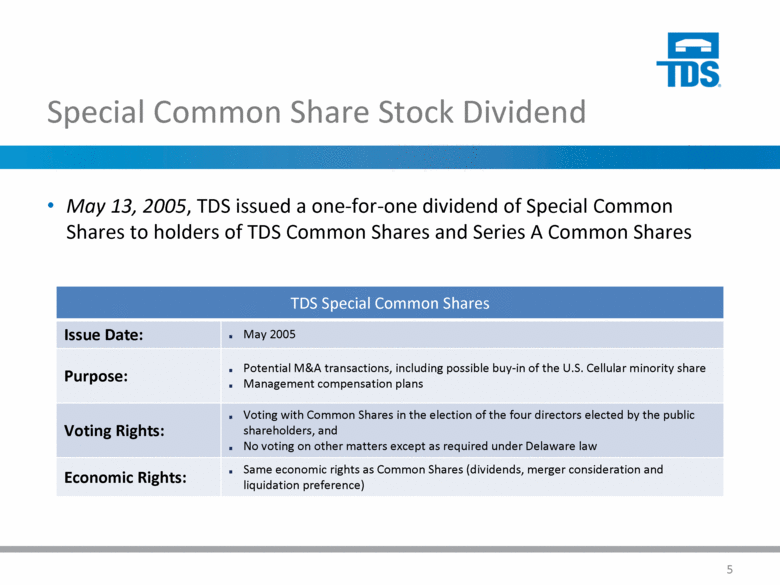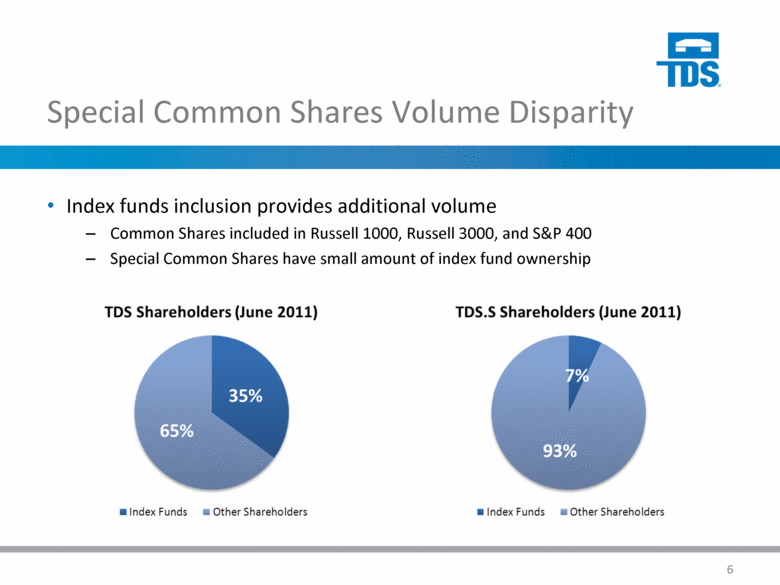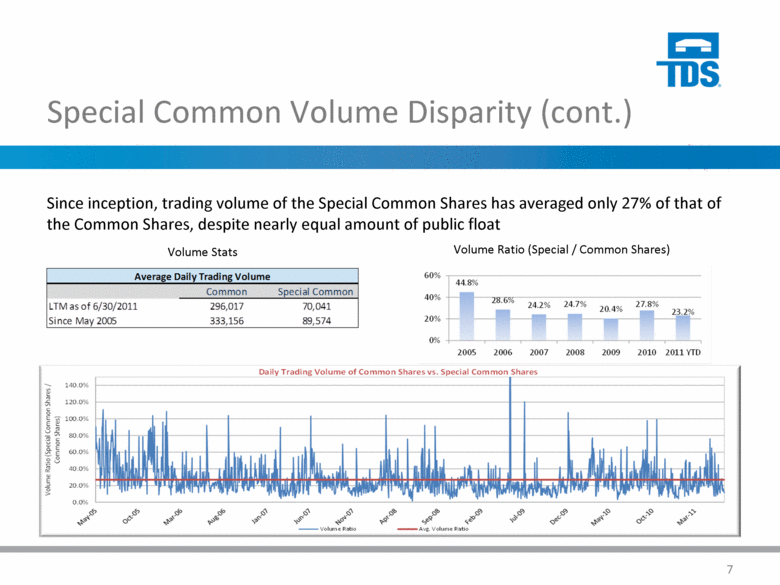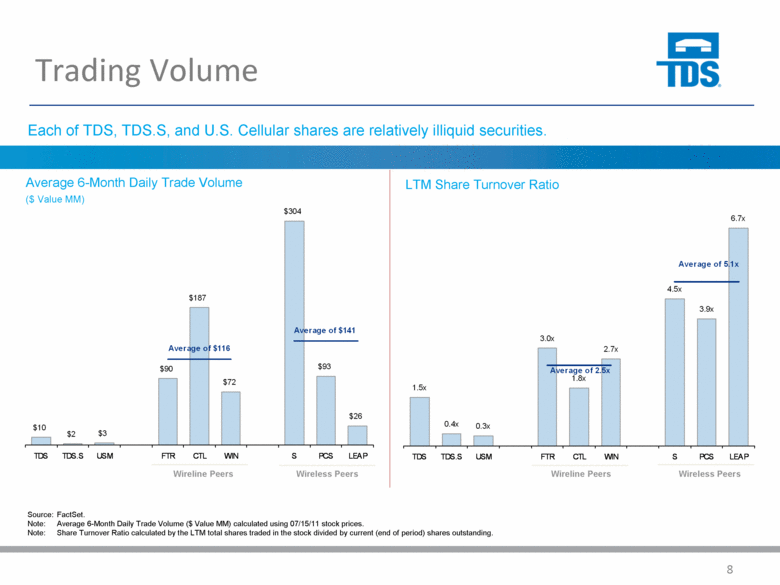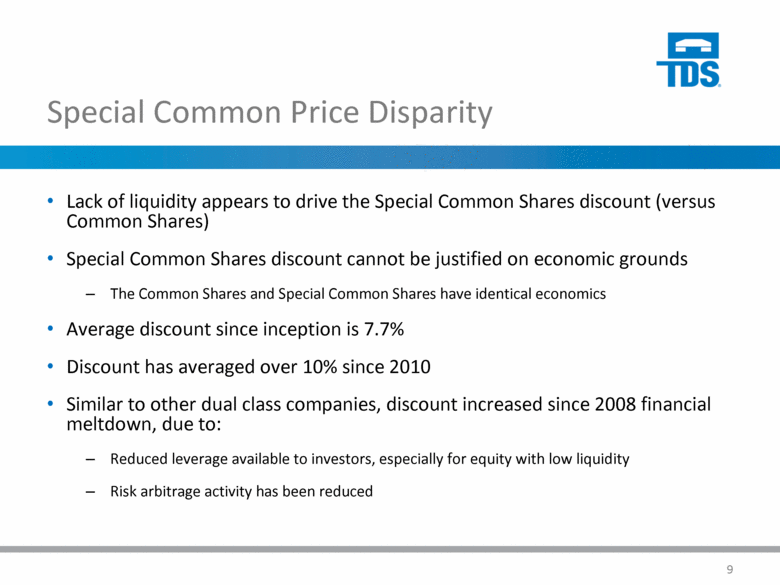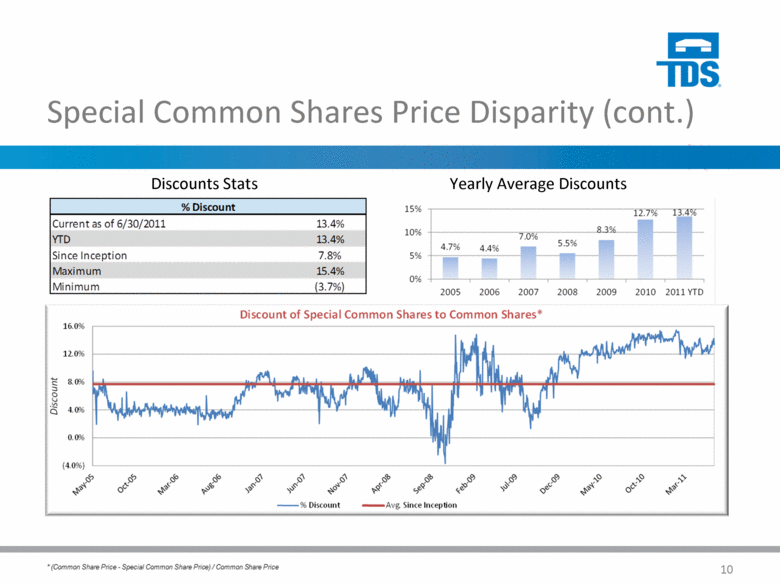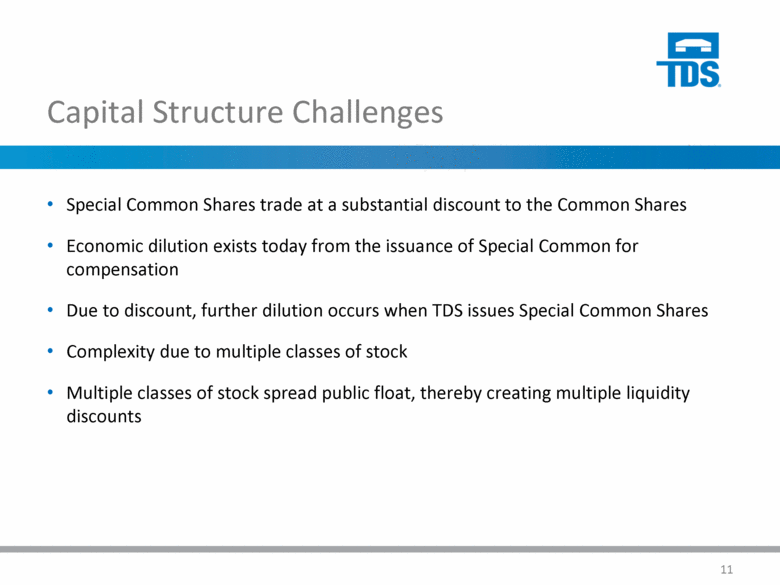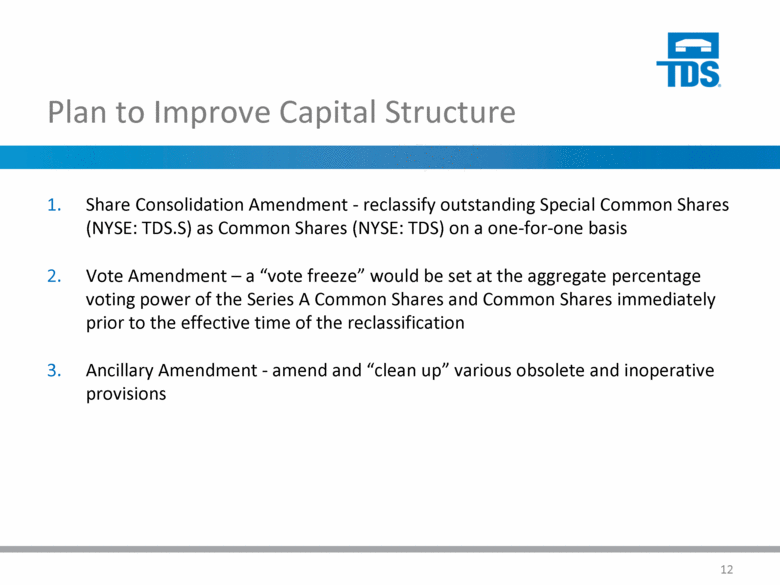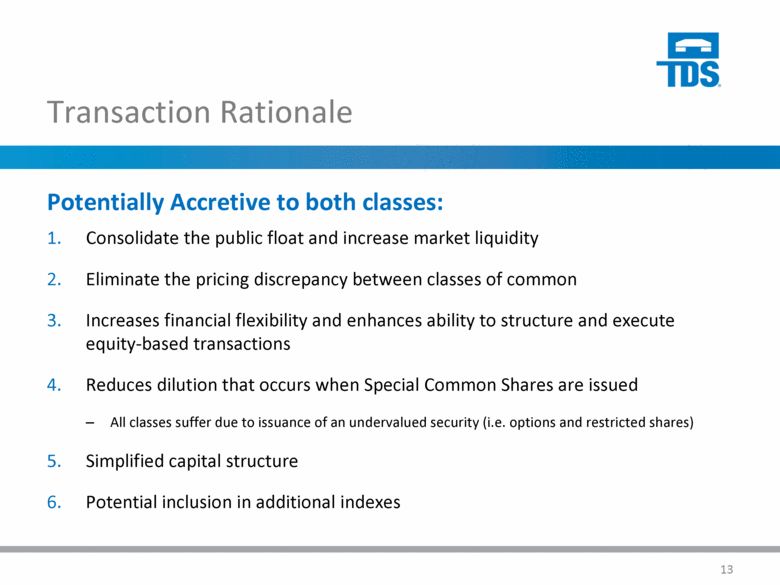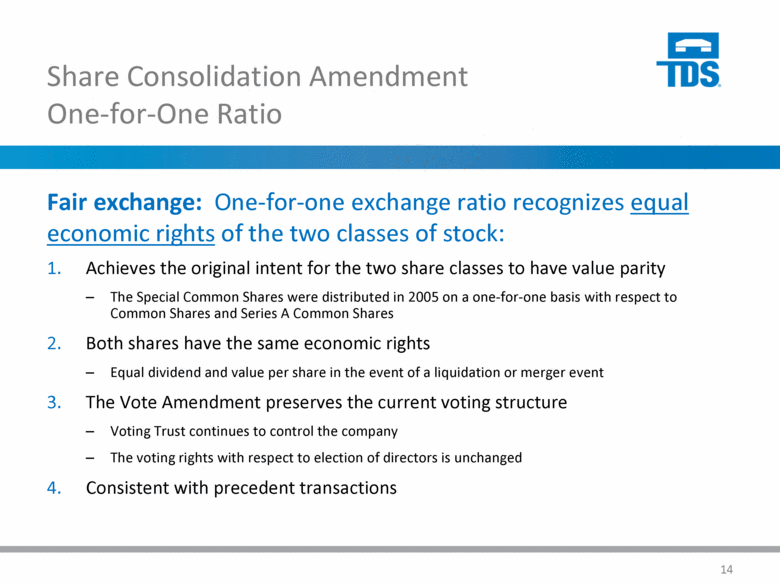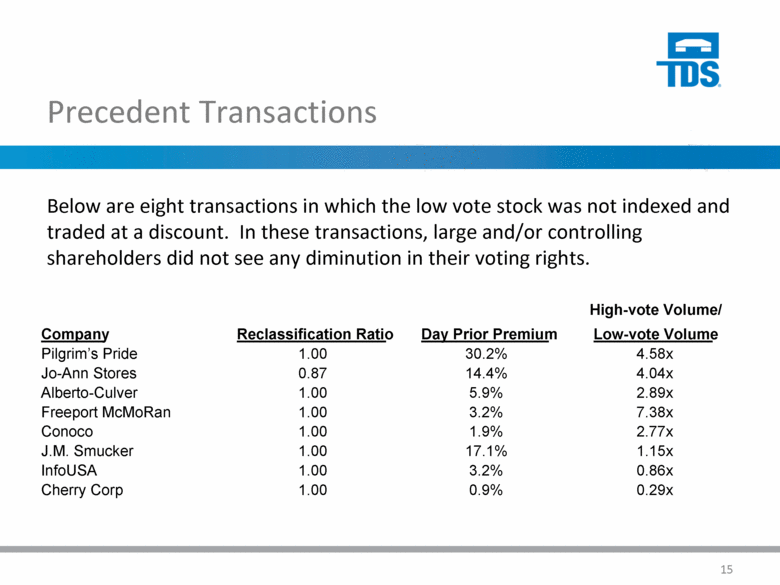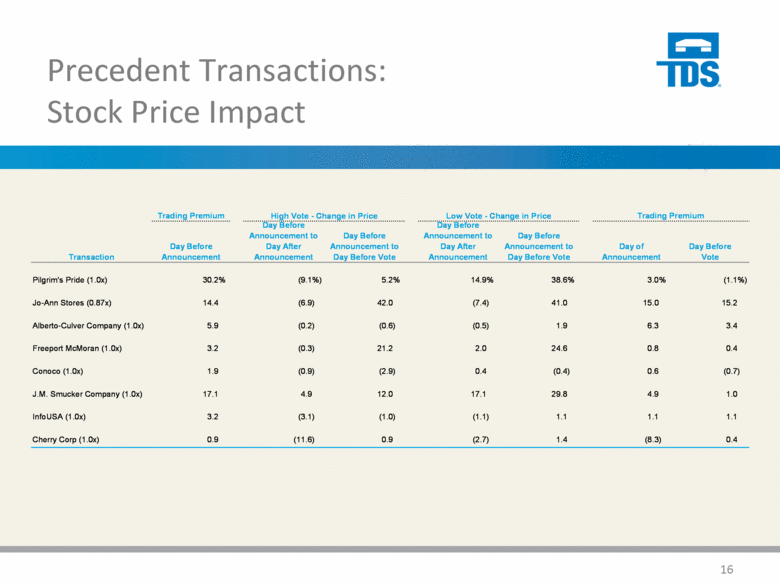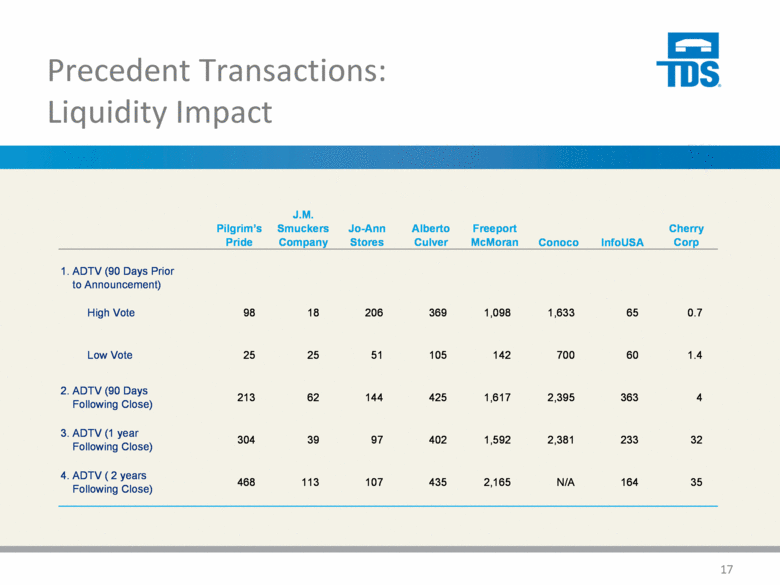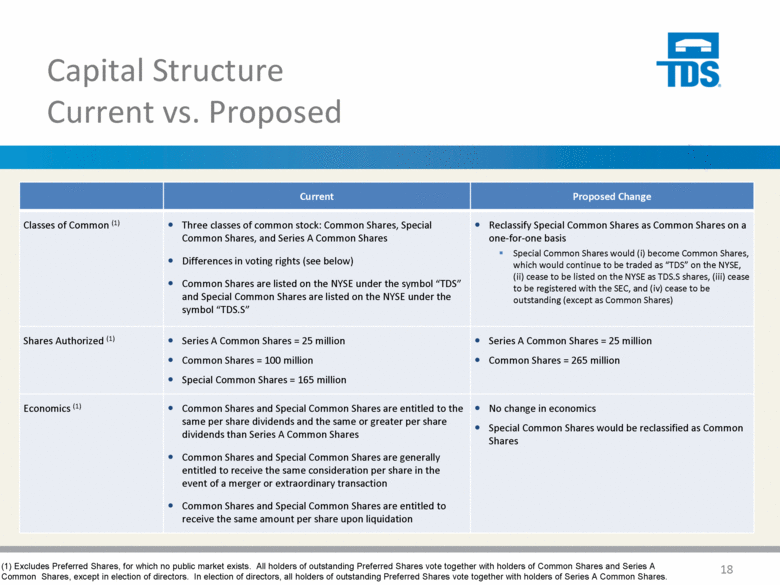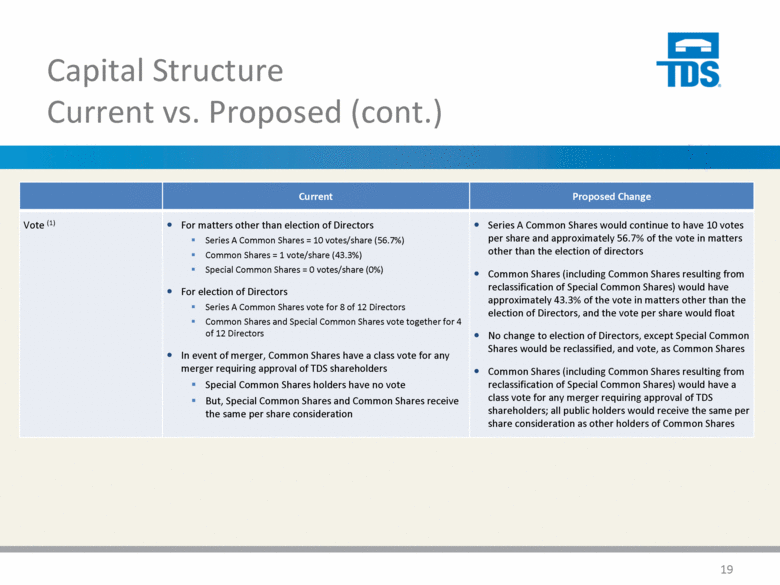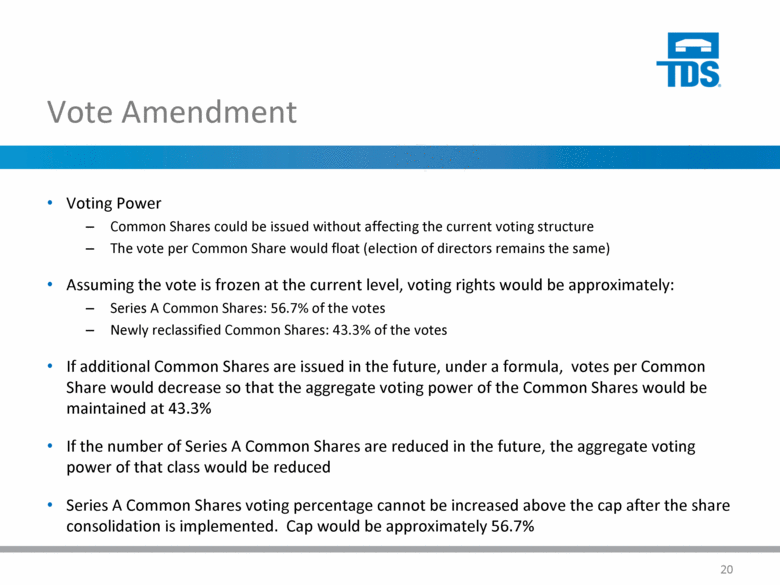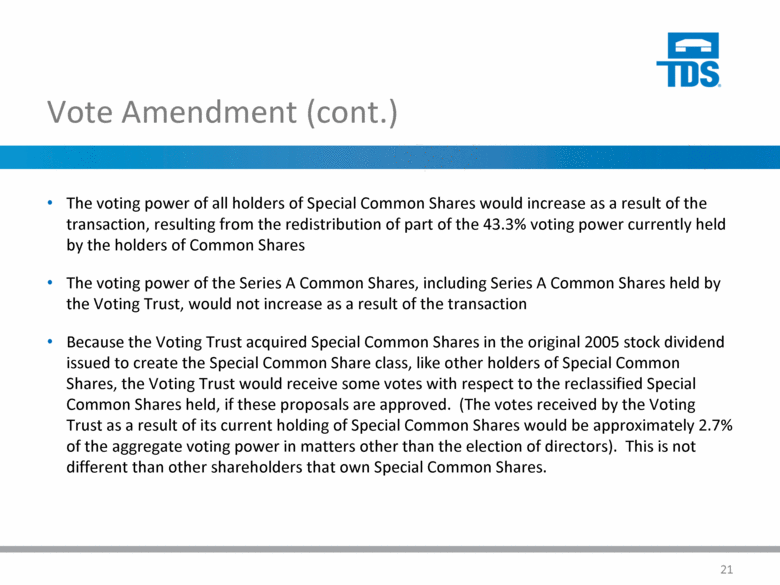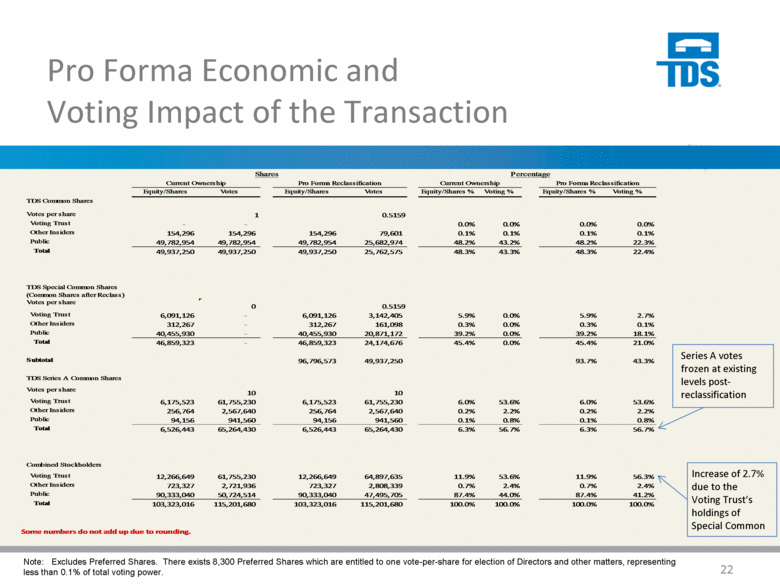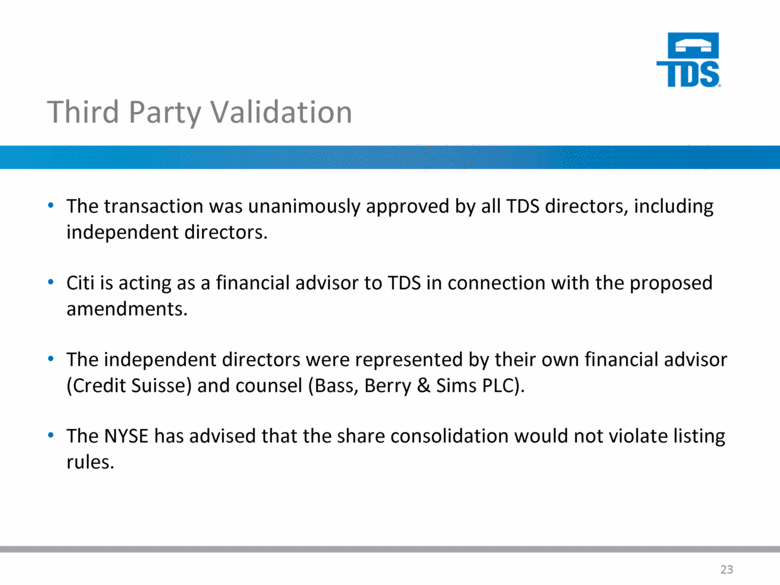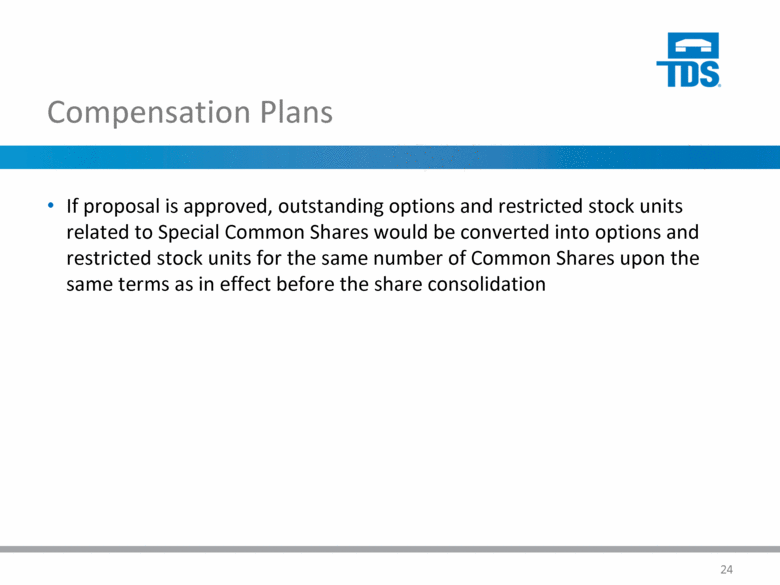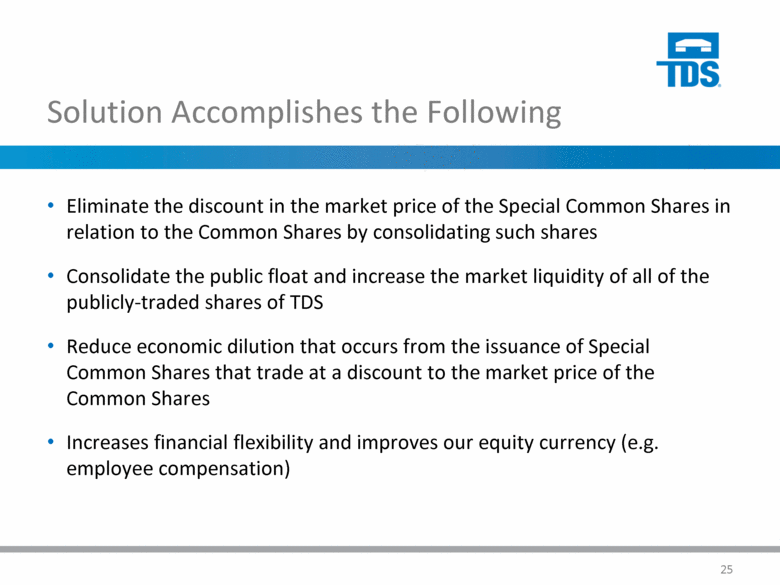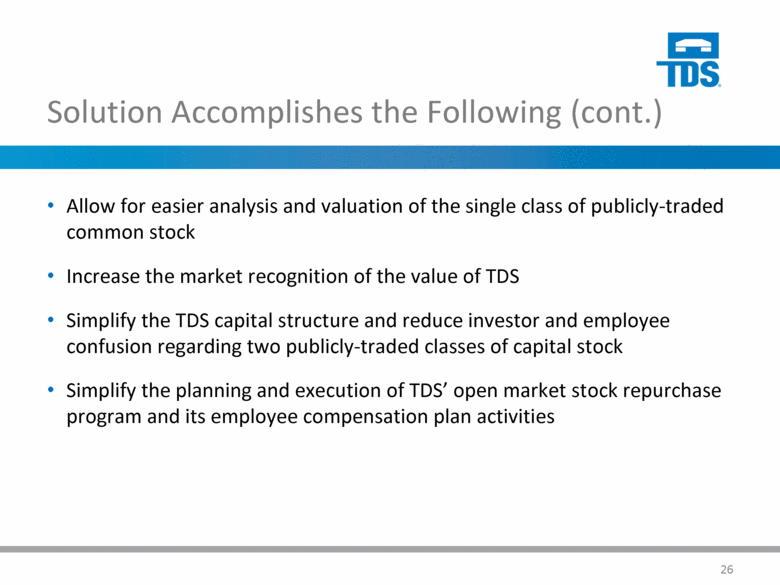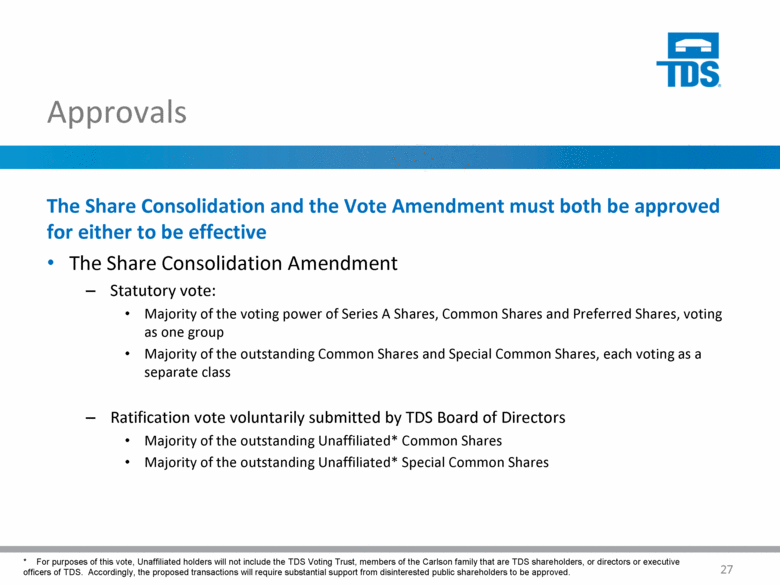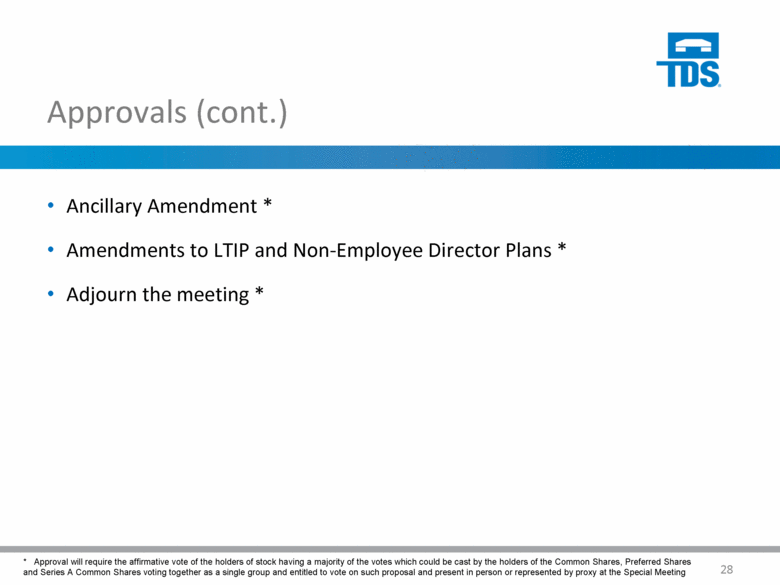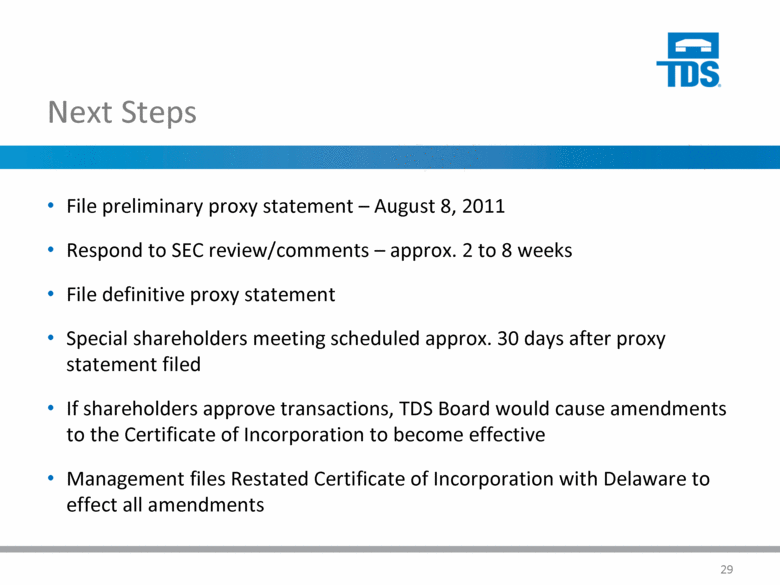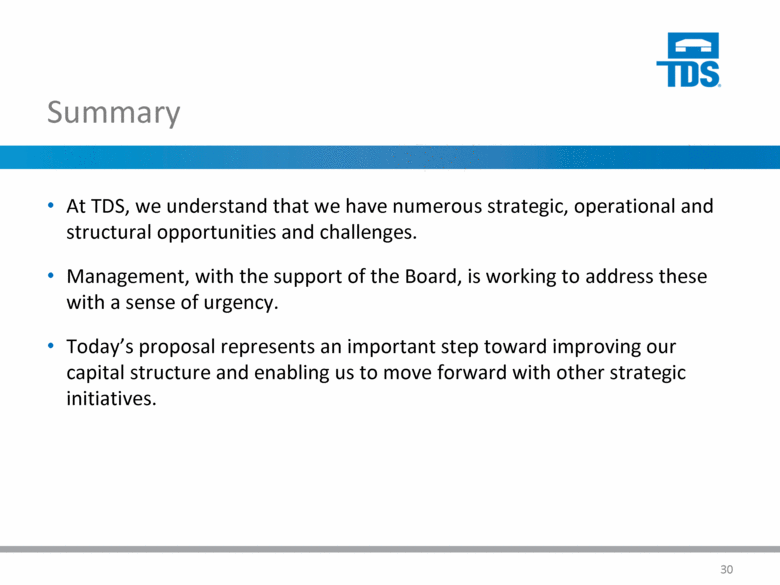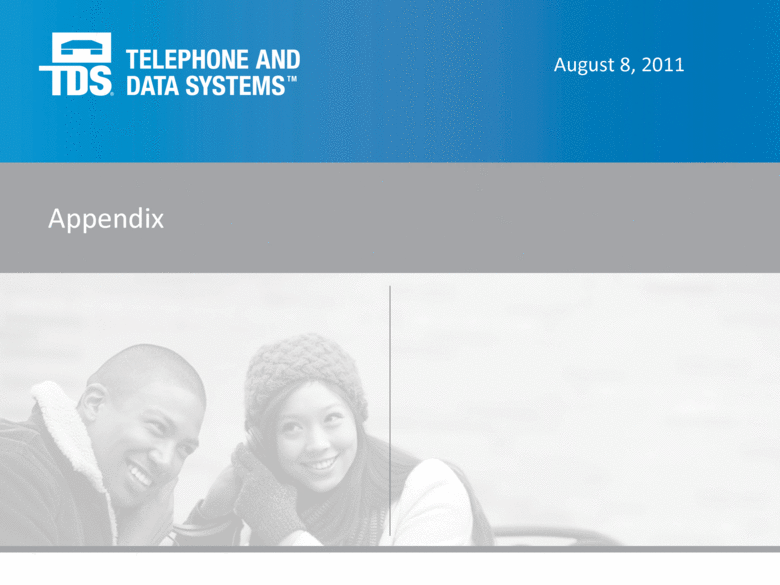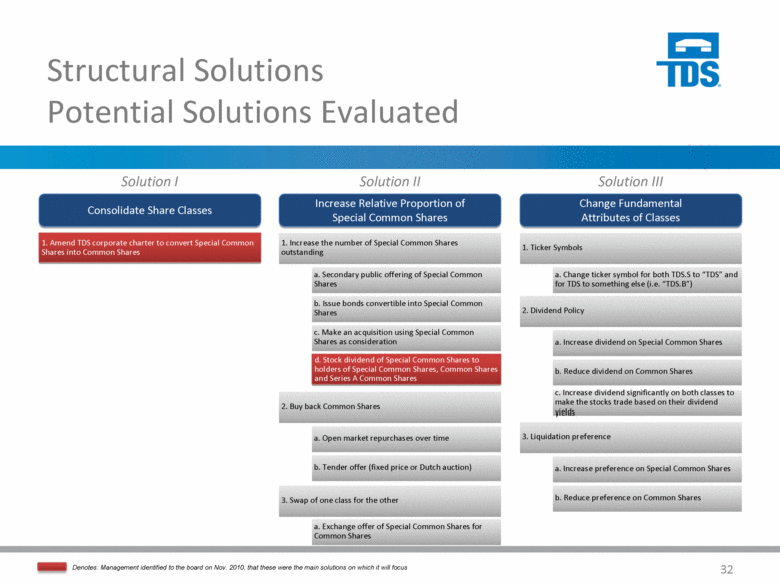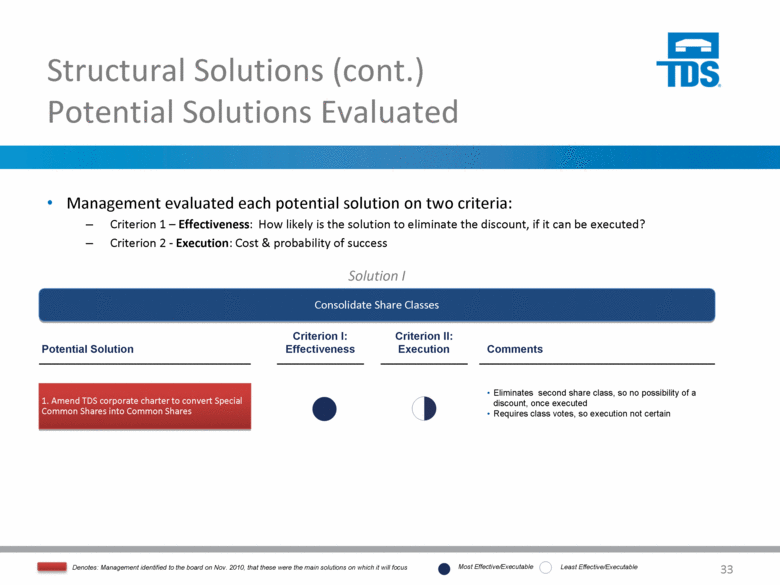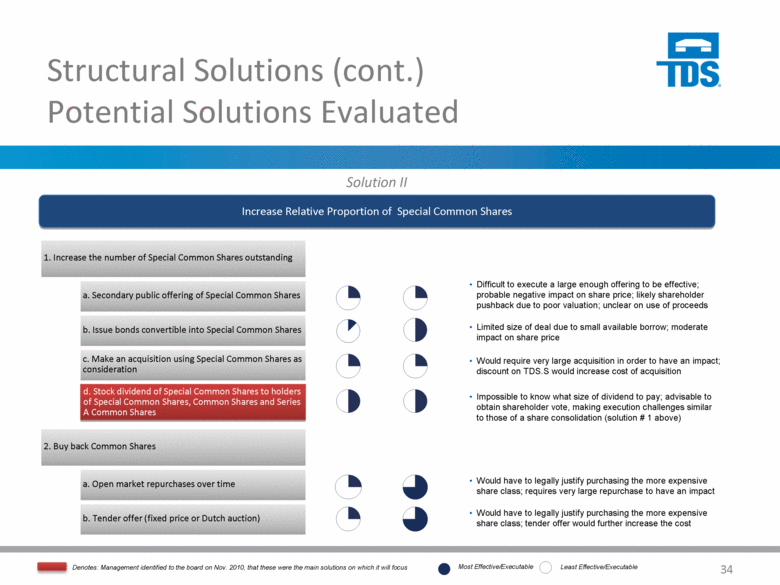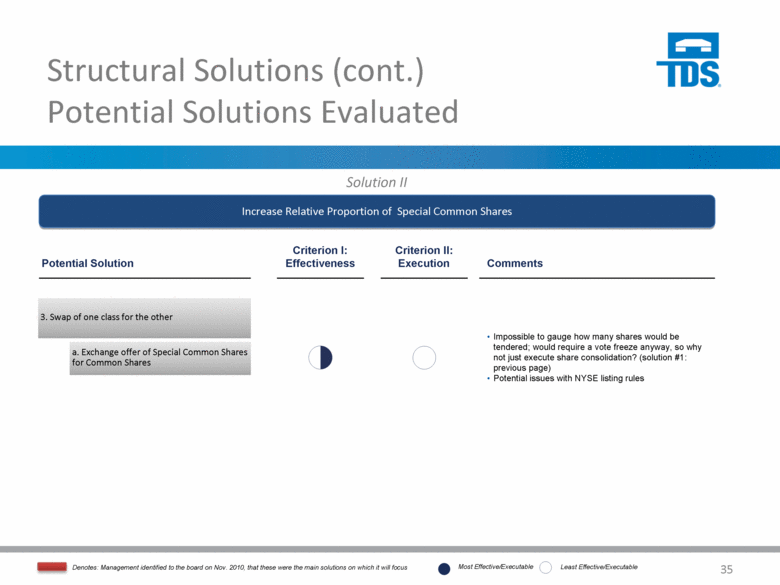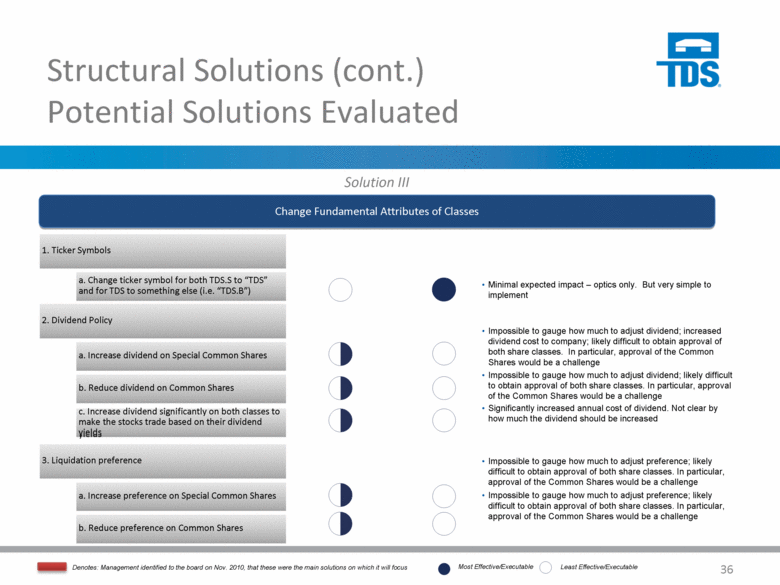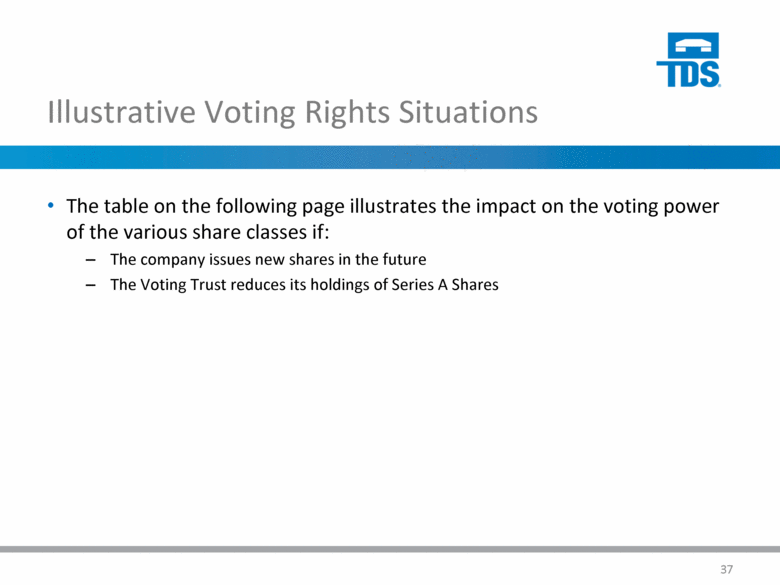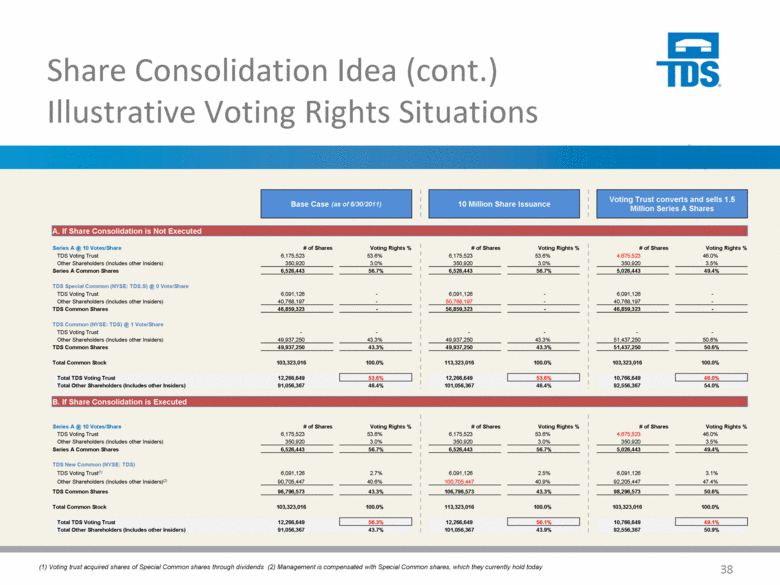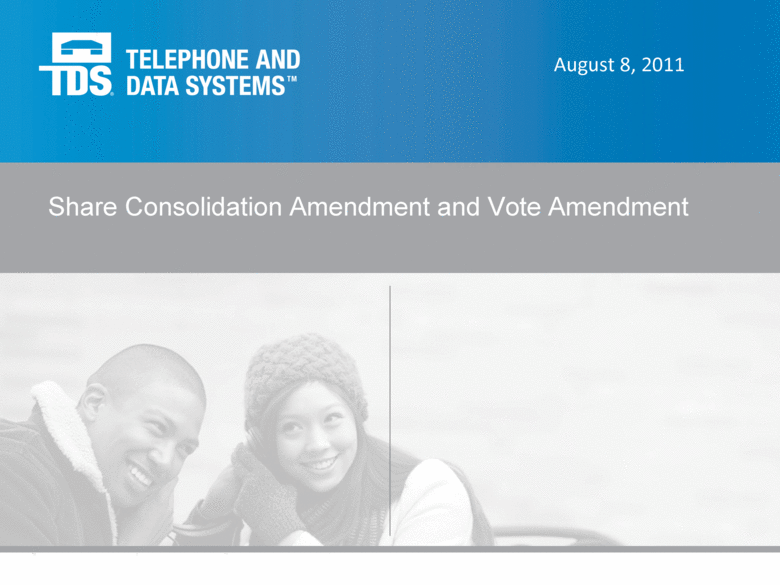Attached files
| file | filename |
|---|---|
| 8-K - 8-K - TELEPHONE & DATA SYSTEMS INC /DE/ | a11-23911_18k.htm |
| EX-99.1 - EX-99.1 - TELEPHONE & DATA SYSTEMS INC /DE/ | a11-23911_1ex99d1.htm |
| EX-99.2 - EX-99.2 - TELEPHONE & DATA SYSTEMS INC /DE/ | a11-23911_1ex99d2.htm |
| EX-99.4 - EX-99.4 - TELEPHONE & DATA SYSTEMS INC /DE/ | a11-23911_1ex99d4.htm |
Exhibit 99.3
|
|
Share Consolidation Amendment and Vote Amendment |
|
|
Safe Harbor Statement Under the Private Securities Litigation Reform Act of 1995: All information set forth in this presentation, except historical and factual information, represents forward-looking statements. This includes all statements about the company’s plans, beliefs, estimates and expectations. These statements are based on current estimates, projections and assumptions, which involve certain risks and uncertainties that could cause actual results to differ materially from those in the forward-looking statements. Important factors that may affect these forward-looking statements include, but are not limited to: the ability of the company to successfully grow its markets; the overall economy; competition; the access to and pricing of unbundled network elements; the ability to obtain or maintain roaming arrangements with other carriers; the state and federal telecommunications regulatory environment; the value of assets and investments; adverse changes in the ratings afforded TDS and U.S. Cellular debt securities by accredited ratings organizations; industry consolidation; advances in telecommunications technology; uncertainty of access to the capital markets; pending and future litigation; changes in income tax rates, laws, regulations or rulings; acquisitions/divestitures of properties and/or licenses; and changes in customer growth rates, average monthly revenue per unit, churn rates, roaming revenue and terms, the availability of handset devices, or the mix of products and services offered by U.S. Cellular and TDS Telecom. Investors are encouraged to consider these and other risks and uncertainties that are discussed in documents filed with the SEC. 2 |
|
|
Important Information This presentation is not a solicitation of a proxy from any TDS shareholder. Additional information relating to the proposals to be submitted to TDS shareholders are included in TDS' preliminary proxy statement and will be included in TDS' definitive proxy statement when it becomes available. INVESTORS AND SECURITY HOLDERS ARE ADVISED TO READ SUCH DOCUMENTS WHEN THEY BECOME AVAILABLE, BECAUSE THEY WILL CONTAIN IMPORTANT INFORMATION. Shareholders and other investors may access such documents without charge when they become available at the SEC's web site (www.sec.gov) and on the TDS web site (www.teldta.com) in the Investor Relations section on the SEC filing page. In addition, shareholders may obtain a free copy of the definitive proxy statement when it is available by contacting MacKenzie Partners at (800) 322-2885. TDS and its executive officers, directors and nominees may be deemed to be participants in the solicitation of proxies from TDS shareholders in connection with the proposals. Information regarding the security ownership and other interests of TDS’ executive officers and directors is included in TDS’ preliminary proxy statement and will be included in TDS’ definitive proxy statement when it is available. 3 |
|
|
History of Special Common Shares (pre-2005) TDS lacked a stock currency Major transactions involving the issuance of Common Shares would change the status quo voting power and would not be supported by the Voting Trust TDS issued a “lower vote” stock to address the issue Stock dividend followed by seasoning period Based on financial advice, TDS believed liquidity (not voting) drove relative trading performance in multi-class structures Market reaction to issuance of Special Common Shares was favorable and it was believed prices would converge Identical economics Voting rights of Common Shares deemed less significant as Voting Trust had control 4 |
|
|
Special Common Share Stock Dividend May 13, 2005, TDS issued a one-for-one dividend of Special Common Shares to holders of TDS Common Shares and Series A Common Shares TDS Special Common Shares Issue Date: May 2005 Purpose: Potential M&A transactions, including possible buy-in of the U.S. Cellular minority share Management compensation plans Voting Rights: Voting with Common Shares in the election of the four directors elected by the public shareholders, and No voting on other matters except as required under Delaware law Economic Rights: Same economic rights as Common Shares (dividends, merger consideration and liquidation preference) 5 |
|
|
Special Common Shares Volume Disparity Index funds inclusion provides additional volume Common Shares included in Russell 1000, Russell 3000, and S&P 400 Special Common Shares have small amount of index fund ownership 6 TDS Shareholders (June 2011) 35% 65% Index Funds Other Shareholders TDS.S Shareholders (June 2011) 7% 93% Index Funds Other Shareholders |
|
|
Special Common Volume Disparity (cont.) Since inception, trading volume of the Special Common Shares has averaged only 27% of that of the Common Shares, despite nearly equal amount of public float Volume Stats Volume Ratio (Special / Common Shares) 7 |
|
|
Trading Volume Wireline Peers Wireless Peers Wireline Peers Wireless Peers Source: FactSet. Note: Average 6-Month Daily Trade Volume ($ Value MM) calculated using 07/15/11 stock prices. Note: Share Turnover Ratio calculated by the LTM total shares traded in the stock divided by current (end of period) shares outstanding. LTM Share Turnover Ratio Average 6-Month Daily Trade Volume ($ Value MM) 8 $10 $2 $3 $90 $187 $72 $304 $93 $26 TDS TDS.S USM FTR CTL WIN S PCS LEAP Average of $116 Average of $141 1.5x 0.4x 0.3x 3.0x 1.8x 2.7x 4.5x 3.9x 6.7x TDS TDS.S USM FTR CTL WIN S PCS LEAP Average of 5.1x Average of 2.5x |
|
|
Special Common Price Disparity Lack of liquidity appears to drive the Special Common Shares discount (versus Common Shares) Special Common Shares discount cannot be justified on economic grounds The Common Shares and Special Common Shares have identical economics Average discount since inception is 7.7% Discount has averaged over 10% since 2010 Similar to other dual class companies, discount increased since 2008 financial meltdown, due to: Reduced leverage available to investors, especially for equity with low liquidity Risk arbitrage activity has been reduced 9 |
|
|
Special Common Shares Price Disparity (cont.) Discounts Stats Yearly Average Discounts 10 |
|
|
Capital Structure Challenges Special Common Shares trade at a substantial discount to the Common Shares Economic dilution exists today from the issuance of Special Common for compensation Due to discount, further dilution occurs when TDS issues Special Common Shares Complexity due to multiple classes of stock Multiple classes of stock spread public float, thereby creating multiple liquidity discounts 11 |
|
|
Plan to Improve Capital Structure Share Consolidation Amendment - reclassify outstanding Special Common Shares (NYSE: TDS.S) as Common Shares (NYSE: TDS) on a one-for-one basis Vote Amendment – a “vote freeze” would be set at the aggregate percentage voting power of the Series A Common Shares and Common Shares immediately prior to the effective time of the reclassification Ancillary Amendment - amend and “clean up” various obsolete and inoperative provisions 12 |
|
|
Transaction Rationale Consolidate the public float and increase market liquidity Eliminate the pricing discrepancy between classes of common Increases financial flexibility and enhances ability to structure and execute equity-based transactions Reduces dilution that occurs when Special Common Shares are issued All classes suffer due to issuance of an undervalued security (i.e. options and restricted shares) Simplified capital structure Potential inclusion in additional indexes Potentially Accretive to both classes: 13 |
|
|
Share Consolidation Amendment One-for-One Ratio Achieves the original intent for the two share classes to have value parity The Special Common Shares were distributed in 2005 on a one-for-one basis with respect to Common Shares and Series A Common Shares Both shares have the same economic rights Equal dividend and value per share in the event of a liquidation or merger event The Vote Amendment preserves the current voting structure Voting Trust continues to control the company The voting rights with respect to election of directors is unchanged Consistent with precedent transactions Fair exchange: One-for-one exchange ratio recognizes equal economic rights of the two classes of stock: 14 |
|
|
Precedent Transactions Below are eight transactions in which the low vote stock was not indexed and traded at a discount. In these transactions, large and/or controlling shareholders did not see any diminution in their voting rights. High-vote Volume/ Company Reclassification Ratio Day Prior Premium Low-vote Volume Pilgrim’s Pride 1.00 30.2% 4.58x Jo-Ann Stores 0.87 14.4% 4.04x Alberto-Culver 1.00 5.9% 2.89x Freeport McMoRan 1.00 3.2% 7.38x Conoco 1.00 1.9% 2.77x J.M. Smucker 1.00 17.1% 1.15x InfoUSA 1.00 3.2% 0.86x Cherry Corp 1.00 0.9% 0.29x 15 |
|
|
Precedent Transactions: Stock Price Impact 16 Trading Premium High Vote - Change in Price Low Vote - Change in Price Trading Premium Transaction Day Before Announcement Day Before Announcement to Day After Announcement Day Before Announcement to Day Before Vote Day Before Announcement to Day After Announcement Day Before Announcement to Day Before Vote Day of Announcement Day Before Vote Pilgrim's Pride (1.0x) 30.2% (9.1%) 5.2% 14.9% 38.6% 3.0% (1.1%) Jo-Ann Stores (0.87x) 14.4 (6.9) 42.0 (7.4) 41.0 15.0 15.2 Alberto-Culver Company (1.0x) 5.9 (0.2) (0.6) (0.5) 1.9 6.3 3.4 Freeport McMoran (1.0x) 3.2 (0.3) 21.2 2.0 24.6 0.8 0.4 Conoco (1.0x) 1.9 (0.9) (2.9) 0.4 (0.4) 0.6 (0.7) J.M. Smucker Company (1.0x) 17.1 4.9 12.0 17.1 29.8 4.9 1.0 InfoUSA (1.0x) 3.2 (3.1) (1.0) (1.1) 1.1 1.1 1.1 Cherry Corp (1.0x) 0.9 (11.6) 0.9 (2.7) 1.4 (8.3) 0.4 |
|
|
Precedent Transactions: Liquidity Impact 17 Pilgrim’s Pride J.M. Smuckers Company Jo-Ann Stores Alberto Culver Freeport McMoran Conoco InfoUSA Cherry Corp 1. ADTV (90 Days Prior to Announcement) High Vote 98 18 206 369 1,098 1,633 65 0.7 Low Vote 25 25 51 105 142 700 60 1.4 2. ADTV (90 Days Following Close) 213 62 144 425 1,617 2,395 363 4 3. ADTV (1 year Following Close) 304 39 97 402 1,592 2,381 233 32 4. ADTV ( 2 years Following Close) 468 113 107 435 2,165 N/A 164 35 |
|
|
Capital Structure Current vs. Proposed Current Proposed Change Classes of Common (1) Three classes of common stock: Common Shares, Special Common Shares, and Series A Common Shares Differences in voting rights (see below) Common Shares are listed on the NYSE under the symbol “TDS” and Special Common Shares are listed on the NYSE under the symbol “TDS.S” Reclassify Special Common Shares as Common Shares on a one-for-one basis Special Common Shares would (i) become Common Shares, which would continue to be traded as “TDS” on the NYSE, (ii) cease to be listed on the NYSE as TDS.S shares, (iii) cease to be registered with the SEC, and (iv) cease to be outstanding (except as Common Shares) Shares Authorized (1) Series A Common Shares = 25 million Common Shares = 100 million Special Common Shares = 165 million Series A Common Shares = 25 million Common Shares = 265 million Economics (1) Common Shares and Special Common Shares are entitled to the same per share dividends and the same or greater per share dividends than Series A Common Shares Common Shares and Special Common Shares are generally entitled to receive the same consideration per share in the event of a merger or extraordinary transaction Common Shares and Special Common Shares are entitled to receive the same amount per share upon liquidation No change in economics Special Common Shares would be reclassified as Common Shares (1) Excludes Preferred Shares, for which no public market exists. All holders of outstanding Preferred Shares vote together with holders of Common Shares and Series A Common Shares, except in election of directors. In election of directors, all holders of outstanding Preferred Shares vote together with holders of Series A Common Shares. 18 |
|
|
Capital Structure Current vs. Proposed (cont.) Current Proposed Change Vote (1) For matters other than election of Directors Series A Common Shares = 10 votes/share (56.7%) Common Shares = 1 vote/share (43.3%) Special Common Shares = 0 votes/share (0%) For election of Directors Series A Common Shares vote for 8 of 12 Directors Common Shares and Special Common Shares vote together for 4 of 12 Directors In event of merger, Common Shares have a class vote for any merger requiring approval of TDS shareholders Special Common Shares holders have no vote But, Special Common Shares and Common Shares receive the same per share consideration Series A Common Shares would continue to have 10 votes per share and approximately 56.7% of the vote in matters other than the election of directors Common Shares (including Common Shares resulting from reclassification of Special Common Shares) would have approximately 43.3% of the vote in matters other than the election of Directors, and the vote per share would float No change to election of Directors, except Special Common Shares would be reclassified, and vote, as Common Shares Common Shares (including Common Shares resulting from reclassification of Special Common Shares) would have a class vote for any merger requiring approval of TDS shareholders; all public holders would receive the same per share consideration as other holders of Common Shares 19 |
|
|
Vote Amendment Voting Power Common Shares could be issued without affecting the current voting structure The vote per Common Share would float (election of directors remains the same) Assuming the vote is frozen at the current level, voting rights would be approximately: Series A Common Shares: 56.7% of the votes Newly reclassified Common Shares: 43.3% of the votes If additional Common Shares are issued in the future, under a formula, votes per Common Share would decrease so that the aggregate voting power of the Common Shares would be maintained at 43.3% If the number of Series A Common Shares are reduced in the future, the aggregate voting power of that class would be reduced Series A Common Shares voting percentage cannot be increased above the cap after the share consolidation is implemented. Cap would be approximately 56.7% 20 |
|
|
Vote Amendment (cont.) The voting power of all holders of Special Common Shares would increase as a result of the transaction, resulting from the redistribution of part of the 43.3% voting power currently held by the holders of Common Shares The voting power of the Series A Common Shares, including Series A Common Shares held by the Voting Trust, would not increase as a result of the transaction Because the Voting Trust acquired Special Common Shares in the original 2005 stock dividend issued to create the Special Common Share class, like other holders of Special Common Shares, the Voting Trust would receive some votes with respect to the reclassified Special Common Shares held, if these proposals are approved. (The votes received by the Voting Trust as a result of its current holding of Special Common Shares would be approximately 2.7% of the aggregate voting power in matters other than the election of directors). This is not different than other shareholders that own Special Common Shares. 21 |
|
|
Pro Forma Economic and Voting Impact of the Transaction Series A votes frozen at existing levels post-reclassification Increase of 2.7% due to the Voting Trust’s holdings of Special Common Note: Excludes Preferred Shares. There exists 8,300 Preferred Shares which are entitled to one vote-per-share for election of Directors and other matters, representing less than 0.1% of total voting power. 22 Shares Percentage Equity/Shares Votes Equity/Shares Votes Equity/Shares % Voting % Equity/Shares % Voting % TDS Common Shares Votes per share 1 0.5159 Voting Trust - - 0.0% 0.0% 0.0% 0.0% Other Insiders 154,296 154,296 154,296 79,601 0.1% 0.1% 0.1% 0.1% Public 49,782,954 49,782,954 49,782,954 25,682,974 48.2% 43.2% 48.2% 22.3% Total 49,937,250 49,937,250 49,937,250 25,762,575 48.3% 43.3% 48.3% 22.4% TDS Special Common Shares (Common Shares after Reclass) Votes per share 0 0.5159 Voting Trust 6,091,126 - 6,091,126 3,142,405 5.9% 0.0% 5.9% 2.7% Other Insiders 312,267 - 312,267 161,098 0.3% 0.0% 0.3% 0.1% Public 40,455,930 - 40,455,930 20,871,172 39.2% 0.0% 39.2% 18.1% Total 46,859,323 - 46,859,323 24,174,676 45.4% 0.0% 45.4% 21.0% Subtotal 96,796,573 49,937,250 93.7% 43.3% TDS Series A Common Shares Votes per share 10 10 Voting Trust 6,175,523 61,755,230 6,175,523 61,755,230 6.0% 53.6% 6.0% 53.6% Other Insiders 256,764 2,567,640 256,764 2,567,640 0.2% 2.2% 0.2% 2.2% Public 94,156 941,560 94,156 941,560 0.1% 0.8% 0.1% 0.8% Total 6,526,443 65,264,430 6,526,443 65,264,430 6.3% 56.7% 6.3% 56.7% Combined Stockholders Voting Trust 12,266,649 61,755,230 12,266,649 64,897,635 11.9% 53.6% 11.9% 56.3% Other Insiders 723,327 2,721,936 723,327 2,808,339 0.7% 2.4% 0.7% 2.4% Public 90,333,040 50,724,514 90,333,040 47,495,705 87.4% 44.0% 87.4% 41.2% Total 103,323,016 115,201,680 103,323,016 115,201,680 100.0% 100.0% 100.0% 100.0% Some numbers do not add up due to rounding. Current Ownership Pro Forma Reclassification Current Ownership Pro Forma Reclassification |
|
|
Third Party Validation The transaction was unanimously approved by all TDS directors, including independent directors. Citi is acting as a financial advisor to TDS in connection with the proposed amendments. The independent directors were represented by their own financial advisor (Credit Suisse) and counsel (Bass, Berry & Sims PLC). The NYSE has advised that the share consolidation would not violate listing rules. 23 |
|
|
Compensation Plans If proposal is approved, outstanding options and restricted stock units related to Special Common Shares would be converted into options and restricted stock units for the same number of Common Shares upon the same terms as in effect before the share consolidation 24 |
|
|
Solution Accomplishes the Following Eliminate the discount in the market price of the Special Common Shares in relation to the Common Shares by consolidating such shares Consolidate the public float and increase the market liquidity of all of the publicly-traded shares of TDS Reduce economic dilution that occurs from the issuance of Special Common Shares that trade at a discount to the market price of the Common Shares Increases financial flexibility and improves our equity currency (e.g. employee compensation) 25 |
|
|
Solution Accomplishes the Following (cont.) Allow for easier analysis and valuation of the single class of publicly-traded common stock Increase the market recognition of the value of TDS Simplify the TDS capital structure and reduce investor and employee confusion regarding two publicly-traded classes of capital stock Simplify the planning and execution of TDS’ open market stock repurchase program and its employee compensation plan activities 26 |
|
|
Approvals The Share Consolidation and the Vote Amendment must both be approved for either to be effective The Share Consolidation Amendment Statutory vote: Majority of the voting power of Series A Shares, Common Shares and Preferred Shares, voting as one group Majority of the outstanding Common Shares and Special Common Shares, each voting as a separate class Ratification vote voluntarily submitted by TDS Board of Directors Majority of the outstanding Unaffiliated* Common Shares Majority of the outstanding Unaffiliated* Special Common Shares * For purposes of this vote, Unaffiliated holders will not include the TDS Voting Trust, members of the Carlson family that are TDS shareholders, or directors or executive officers of TDS. Accordingly, the proposed transactions will require substantial support from disinterested public shareholders to be approved. 27 |
|
|
Approvals (cont.) Ancillary Amendment * Amendments to LTIP and Non-Employee Director Plans * Adjourn the meeting * * Approval will require the affirmative vote of the holders of stock having a majority of the votes which could be cast by the holders of the Common Shares, Preferred Shares and Series A Common Shares voting together as a single group and entitled to vote on such proposal and present in person or represented by proxy at the Special Meeting 28 |
|
|
Next Steps File preliminary proxy statement – August 8, 2011 Respond to SEC review/comments – approx. 2 to 8 weeks File definitive proxy statement Special shareholders meeting scheduled approx. 30 days after proxy statement filed If shareholders approve transactions, TDS Board would cause amendments to the Certificate of Incorporation to become effective Management files Restated Certificate of Incorporation with Delaware to effect all amendments 29 |
|
|
Summary At TDS, we understand that we have numerous strategic, operational and structural opportunities and challenges. Management, with the support of the Board, is working to address these with a sense of urgency. Today’s proposal represents an important step toward improving our capital structure and enabling us to move forward with other strategic initiatives. 30 |
|
|
Appendix |
|
|
Structural Solutions Potential Solutions Evaluated Consolidate Share Classes Increase Relative Proportion of Special Common Shares Change Fundamental Attributes of Classes Solution I Solution II Solution III 1. Amend TDS corporate charter to convert Special Common Shares into Common Shares 1. Increase the number of Special Common Shares outstanding a. Secondary public offering of Special Common Shares b. Issue bonds convertible into Special Common Shares c. Make an acquisition using Special Common Shares as consideration d. Stock dividend of Special Common Shares to holders of Special Common Shares, Common Shares and Series A Common Shares 2. Buy back Common Shares a. Open market repurchases over time b. Tender offer (fixed price or Dutch auction) 3. Swap of one class for the other a. Exchange offer of Special Common Shares for Common Shares 1. Ticker Symbols a. Change ticker symbol for both TDS.S to “TDS” and for TDS to something else (i.e. “TDS.B”) 2. Dividend Policy a. Increase dividend on Special Common Shares b. Reduce dividend on Common Shares c. Increase dividend significantly on both classes to make the stocks trade based on their dividend yields 3. Liquidation preference a. Increase preference on Special Common Shares b. Reduce preference on Common Shares Denotes: Management identified to the board on Nov. 2010, that these were the main solutions on which it will focus 32 |
|
|
Structural Solutions (cont.) Potential Solutions Evaluated Management evaluated each potential solution on two criteria: Criterion 1 – Effectiveness: How likely is the solution to eliminate the discount, if it can be executed? Criterion 2 - Execution: Cost & probability of success Consolidate Share Classes Solution I Potential Solution Criterion I: Effectiveness Criterion II: Execution Comments Eliminates second share class, so no possibility of a discount, once executed Requires class votes, so execution not certain 1. Amend TDS corporate charter to convert Special Common Shares into Common Shares Denotes: Management identified to the board on Nov. 2010, that these were the main solutions on which it will focus Most Effective/Executable Least Effective/Executable 33 |
|
|
Structural Solutions (cont.) Potential Solutions Evaluated Increase Relative Proportion of Special Common Shares Solution II 1. Increase the number of Special Common Shares outstanding a. Secondary public offering of Special Common Shares b. Issue bonds convertible into Special Common Shares c. Make an acquisition using Special Common Shares as consideration d. Stock dividend of Special Common Shares to holders of Special Common Shares, Common Shares and Series A Common Shares 2. Buy back Common Shares a. Open market repurchases over time b. Tender offer (fixed price or Dutch auction) Difficult to execute a large enough offering to be effective; probable negative impact on share price; likely shareholder pushback due to poor valuation; unclear on use of proceeds Limited size of deal due to small available borrow; moderate impact on share price Would require very large acquisition in order to have an impact; discount on TDS.S would increase cost of acquisition Impossible to know what size of dividend to pay; advisable to obtain shareholder vote, making execution challenges similar to those of a share consolidation (solution # 1 above) Would have to legally justify purchasing the more expensive share class; requires very large repurchase to have an impact Would have to legally justify purchasing the more expensive share class; tender offer would further increase the cost Denotes: Management identified to the board on Nov. 2010, that these were the main solutions on which it will focus Most Effective/Executable Least Effective/Executable 34 |
|
|
Structural Solutions (cont.) Potential Solutions Evaluated Denotes: Management identified to the board on Nov. 2010, that these were the main solutions on which it will focus Most Effective/Executable Least Effective/Executable Increase Relative Proportion of Special Common Shares Solution II Potential Solution Criterion I: Effectiveness Criterion II: Execution Comments Impossible to gauge how many shares would be tendered; would require a vote freeze anyway, so why not just execute share consolidation? (solution #1: previous page) Potential issues with NYSE listing rules 3. Swap of one class for the other a. Exchange offer of Special Common Shares for Common Shares 35 |
|
|
Structural Solutions (cont.) Potential Solutions Evaluated Change Fundamental Attributes of Classes Solution III 1. Ticker Symbols a. Change ticker symbol for both TDS.S to “TDS” and for TDS to something else (i.e. “TDS.B”) 2. Dividend Policy a. Increase dividend on Special Common Shares b. Reduce dividend on Common Shares c. Increase dividend significantly on both classes to make the stocks trade based on their dividend yields 3. Liquidation preference a. Increase preference on Special Common Shares b. Reduce preference on Common Shares Minimal expected impact – optics only. But very simple to implement Impossible to gauge how much to adjust dividend; increased dividend cost to company; likely difficult to obtain approval of both share classes. In particular, approval of the Common Shares would be a challenge Impossible to gauge how much to adjust dividend; likely difficult to obtain approval of both share classes. In particular, approval of the Common Shares would be a challenge Significantly increased annual cost of dividend. Not clear by how much the dividend should be increased Impossible to gauge how much to adjust preference; likely difficult to obtain approval of both share classes. In particular, approval of the Common Shares would be a challenge Impossible to gauge how much to adjust preference; likely difficult to obtain approval of both share classes. In particular, approval of the Common Shares would be a challenge Denotes: Management identified to the board on Nov. 2010, that these were the main solutions on which it will focus Most Effective/Executable Least Effective/Executable 36 |
|
|
Illustrative Voting Rights Situations The table on the following page illustrates the impact on the voting power of the various share classes if: The company issues new shares in the future The Voting Trust reduces its holdings of Series A Shares 37 |
|
|
Share Consolidation Idea (cont.) Illustrative Voting Rights Situations (1) Voting trust acquired shares of Special Common shares through dividends (2) Management is compensated with Special Common shares, which they currently hold today 38 Base Case (as of 6/30/2011) 10 Million Share Issuance Voting Trust converts and sells 1.5 Million Series A Shares A. If Share Consolidation is Not Executed Series A @ 10 Votes/Share # of Shares Voting Rights % # of Shares Voting Rights % # of Shares Voting Rights % TDS Voting Trust 6,175,523 53.6% 6,175,523 53.6% 4,675,523 46.0% Other Shareholders (Includes other Insiders) 350,920 3.0% 350,920 3.0% 350,920 3.5% Series A Common Shares 6,526,443 56.7% 6,526,443 56.7% 5,026,443 49.4% TDS Special Common (NYSE: TDS.S) @ 0 Vote/Share TDS Voting Trust 6,091,126 - 6,091,126 - 6,091,126 - Other Shareholders (Includes other Insiders) 40,768,197 - 50,768,197 - 40,768,197 - TDS Common Shares 46,859,323 - 56,859,323 - 46,859,323 - TDS Common (NYSE: TDS) @ 1 Vote/Share TDS Voting Trust - - - - - - Other Shareholders (Includes other Insiders) 49,937,250 43.3% 49,937,250 43.3% 51,437,250 50.6% TDS Common Shares 49,937,250 43.3% 49,937,250 43.3% 51,437,250 50.6% Total Common Stock 103,323,016 100.0% 113,323,016 100.0% 103,323,016 100.0% Total TDS Voting Trust 12,266,649 53.6% 12,266,649 53.6% 10,766,649 46.0% Total Other Shareholders (Includes other Insiders) 91,056,367 46.4% 101,056,367 46.4% 92,556,367 54.0% B. If Share Consolidation is Executed Series A @ 10 Votes/Share # of Shares Voting Rights % # of Shares Voting Rights % # of Shares Voting Rights % TDS Voting Trust 6,175,523 53.6% 6,175,523 53.6% 4,675,523 46.0% Other Shareholders (Includes other Insiders) 350,920 3.0% 350,920 3.0% 350,920 3.5% Series A Common Shares 6,526,443 56.7% 6,526,443 56.7% 5,026,443 49.4% TDS New Common (NYSE: TDS) TDS Voting Trust(1) 6,091,126 2.7% 6,091,126 2.5% 6,091,126 3.1% Other Shareholders (Includes other Insiders)(2) 90,705,447 40.6% 100,705,447 40.9% 92,205,447 47.4% TDS Common Shares 96,796,573 43.3% 106,796,573 43.3% 98,296,573 50.6% Total Common Stock 103,323,016 100.0% 113,323,016 100.0% 103,323,016 100.0% Total TDS Voting Trust 12,266,649 56.3% 12,266,649 56.1% 10,766,649 49.1% Total Other Shareholders (Includes other Insiders) 91,056,367 43.7% 101,056,367 43.9% 92,556,367 50.9% |
|
|
Share Consolidation Amendment and Vote Amendment |

